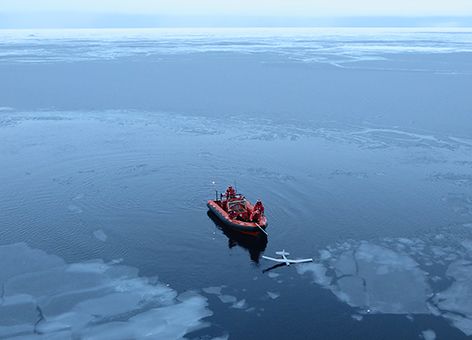NOAA Again Joins Coast Guard for Oil Spill Exercise in the Arctic
AUGUST 6, 2014 -- It is no mystery anymore that the Arctic is undergoing unprecedented change and the extent of summer sea ice continues to shrink.
As the ice contracts, shipping within and across the Arctic, oil and gas exploration, and tourism likely will increase, as will fishing, if fisheries continue migrating north to cooler waters. With more oil-powered activity in the Arctic and potentially out-of-date nautical charts, the region also will see an increased risk of oil spills.
Although the Arctic may have "ice-free" summers, it will remain a difficult place to respond to spills, still facing conditions such as low visibility, mobilized icebergs, and extreme cold.
Much of the increased activity exploits the longer amount of time between the sea ice breaking up in the spring and freezing up in the fall. Accidents on either end of this longer window could mean responding to oil spills complicated by sea ice.
Ready, Set, (Pretend to) Spill
With these challenging circumstances in mind, NOAA's Office of Response and Restoration again will be sending spatial data specialists aboard the Coast Guard icebreaker Healy for an Arctic Technology Evaluation, a month-long scientific expedition to the Arctic Ocean to demonstrate and evaluate oil spill tools, technologies, and techniques as part of Arctic Shield 2014.
The ship leaves for the edge of the sea ice from Seward, Alaska, on August 8. We will be working with the U.S. Coast Guard Research and Development Center (RDC) to operate Arctic ERMA, our mapping tool geared at oil spill response. Normally an online tool, a special internet-independent version of ERMA, known as Stand-alone ERMA, will serve as the common operational picture for scientific data during this Arctic Technology Evaluation.
NOAA provides scientific support to the Coast Guard during oil and chemical spills, and ERMA is an extension of that support. This Arctic Technology Evaluation is an opportunity to work with the Coast Guard in as realistic conditions as possible—on a ship in the Arctic Ocean. Once the Healy makes it far enough north, the Coast Guard RDC will deploy a simulated oil spill so they can test oil spill detection and recovery technologies in ice conditions.
The team will test unmanned technology platforms (both airborne and underwater) to detect where the spilled "oil" is and to collect ocean condition data, such as sea temperature, currents, and the areas where oil is mixing and spreading in the water column. In this case the simulated oil will be fluorescein dye, an inert tracer used for other simulated spills and water transport studies in the ocean and rivers. (Other simulated spilled "oils" have included peat moss, rubber ducks, and oranges.)
One major objective is for NOAA's Unmanned Aircraft Systems group to fly their 8.5 foot wingspan, remote-controlled Puma, instead of an airplane with a human observer, to delineate the extent of the "oil" plume. ERMA's job will be to display the data from the Puma and other unmanned technologies so all of the team can see where measurements have been taken and identify insights into how they could hypothetically clean up a spill in the remote, icy environment.
Arriving at the Arctic
In many ways, this office is a newcomer to the Arctic, and we still have a lot to learn about past research and current ways of life in the region. As the NOAA co-director for the Coastal Response Research Center (a joint partnership with the University of New Hampshire), Amy Merten worked with her co-director, UNH professor Nancy Kinner, to promote understanding of the risks the Arctic is facing.
In 2007, they participated in a joint industry study which brought them to the Arctic at the SINTEF lab on Svalbard in Norway. Here, Merten saw firsthand how difficult it can be to find oil mixed in ice and then try to do something about it, such as burn it. The temperature extremes in the Arctic limit mobility and the amount of time one can be outside responding to a spill—if you can get to the spill in the first place.
At the same time, they were developing ERMA® (Environmental Response Management Application), a web-based mapping tool for environmental response, which is customized for various regions in the United States.
As NOAA's Office of Response and Restoration began developing strategies for working in the Arctic, support emerged for customizing ERMA for the Arctic region. They worked with several organizations, including Arctic communities, to develop Arctic ERMA, taking care to make connections and build relationships with the people who live in and know the region and its natural resources. ERMA also will use the Healy's onboard satellite communications to relay data back to the live Arctic ERMA website, allowing people outside the vessel to stay up-to-date with the mission.
Merten is excited for her ERMA colleagues, Jill Bodnar and Zach Winters-Staszak, to experience this extreme and special environment firsthand. Academically, you can think through the challenges a spill in the Arctic would present, but actually experiencing it quickly reveals what will and will not work. Partnering with the Coast Guard is helping those of us at NOAA be proactive responders in general, and in particular, is teaching the ERMA team how to pull into this tool data from multiple platforms and improve response decision-making.
We're all connected to the Arctic; weather and oceanographic patterns are changing world wide because of the rapidly changing Arctic. Oil and gas coming from the Arctic will fuel the U.S. economy and current way of life for the foreseeable future. We hope that Arctic Shield and other oil spill exercises will better prepare us for whatever happens next. Follow along with NOAA’s efforts during Arctic Shield at https://oceanservice.noaa.gov/news/welcome.php.
 An official website of the United States government.
An official website of the United States government. 

